I am planning on making a Java Swing application and was wondering if Swing is still used or if it has been replaced with something else.
Thanks in advance!
I am planning on making a Java Swing application and was wondering if Swing is still used or if it has been replaced with something else.
Thanks in advance!
Swing is still in use.... but there is AWT!!
Pros:
Cons:
Pros:
Cons:
Swing is still there and well supported.
Most of the reasons why people hated swing when it first came out are no longer valid simply because of Moores Law, along with improved JVMs. Swing apps no loger feel jerky and unrepsonsive and an accumulation of minor improvements result in a more professional looking GUI.
Its also worth looking at the "groovy/swing" combination for rapid development and prototyping.
Yes. Roughly 1 out of 120 questions on StackOverflow is about Swing .
.
We still use it. Not everything is a web app, so far there have been some tentative replacements (such as SWT, which eclipse is written in)
SWT has a native layer that wraps the underlying calls to the native windowing layer. It only works for a limited set of platforms and of course requires some third party shared libraries. I would venture to say that there are far fewer SWT apps than Swing apps.
Yes, it still is in use. The library is still part of the JRE, and will probably be that way for the future. There are other options though. For instance, you may want to look at JavaFX if you need a rich UI; or using SWT in your application. Maybe you want some kind of 3D effects, and you need to look into a 3D engine like jpct or the jmonkeyengine. Java has progressed somewhat since the software Swing world.
Although swing is still in use, I would rather chose Eclipse RCP as a platform for desktop applications, since it also provides a huge amount of plugins.
Yes, it's still in use. Takes while to get used to but once you have it, it's a pretty nice framework for writing applications. Have a look at Webstart for deploying your application. Also a bit of a clunker to start with but really handy when you're comfortable
For desktop programs, yes, Swing is heavily in use. However there are many alternatives because alot of people think that Swing is heavily verbose and hard to work with. JavaFX is worth taking a look at
You can still use Java Swing, though I'd recommend using JavaFX. Designing UIs is easier as the SceneBuilder helps you do just that. It is also newer, so longer support and development. The advantage of Swing is that it has been out for quite a long time, so you'll find more tutorials and help for Swing, but JavaFX is catching up. If you'd like to learn JavaFX, I recommend following the tutorial series by thenewboston on YouTube.
Swing is still the preferred way to build heavy-weight, e.g. "Desktop" applications, in Java. If your code is running in a web browser, you will likely use other things. But for freestanding desktop apps, it is quite excellent and in wide use.